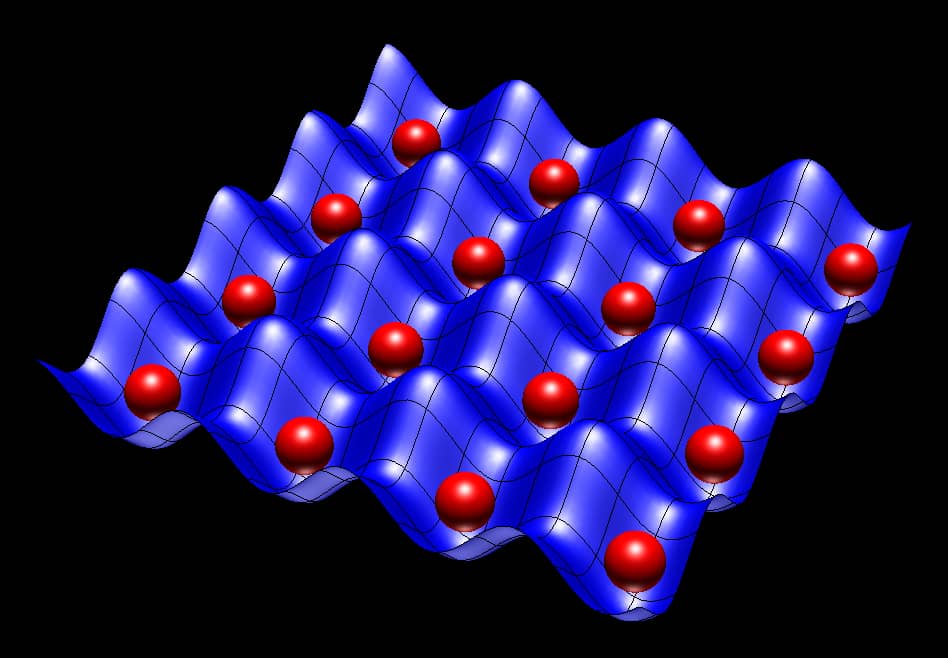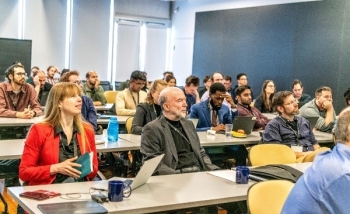Physicists don’t know much about how large quantum systems evolve over time. Until a few years ago, they didn’t think they needed to.
Quantum systems tend to be small, not large. When you consider only a few atoms at a time, you might see quantum effects like superposition (where particles seem to be in two states at once) or entanglement (where particles seem to affect each other instantaneously, at a distance). When you get lots of atoms together, these strange effects vanish.
This process – this averaging out of the quantum effects and other interesting features – is called thermalization. Recently, physicists have made progress in understanding why conventional many-body systems thermalize, and how statistical mechanics emerges from microscopic, quantum description. It’s complex, but the short version is that a system of many particles quickly comes to equilibrium. That equilibrium state looks classical, and can be completely described by the classical theory of statistical mechanics. It’s as if the interactions between particles wash away all the quantum-ness.
As for evolving in time, thermalization usually happens so quickly that the evolution of quantum effects hasn’t really been a consideration. But this changed when researchers discovered a class of systems – systems with strong disorder – which do not thermalize.
By finding new ways to isolate quantum systems from their environments, researchers have been able to create and study these systems in the lab. For instance, researchers have learned to catch hundreds of atoms in a magnetic trap, cool them, and study their quantum evolution. Inside specially prepared diamonds, other researchers have found tiny cavities, with one atom in each. The spin of the atom does not interact with the cavity, but does interact with the spin of the atom in the next cave over – making a fundamentally quantum system of spins that persists through time.
These kinds of systems – technically called localized many-body systems – are a new and hot field. Fuelling the interest is not just a basic desire to understand how nature works, but the pressing need to build lasting quantum systems in order to use them for quantum information processors. If we are ever to capitalize on the promise of quantum computing, engineering many-body quantum systems is a vital early step.
The emergence of systems where quantum effects persist through time throws a spotlight on our ignorance about how quantum systems evolve – and gives us a chance to remedy that ignorance by finally allowing us to study such systems. We’ve learned, for instance, that they do not conform to our usual understanding of statistical mechanics. New laws of dynamics must be found.
Enter a team of Perimeter researchers.
In new papers appearing in Physical Review Letters, Perimeter Faculty member Dmitry Abanin, Perimeter Postdoctoral Researcher Zlatko Papić, and Maksym Serbyn (a graduate student at MIT and a Perimeter visitor) describe the laws which govern dynamics in disordered many-body quantum systems. These new laws of quantum statistics can be used in place of the traditional laws of statistical mechanics.
This is a general result, which can be applied to any strongly disordered experimental quantum many-body system. It’s expected to be of widespread use as researchers create and study more such systems.
One immediate result is a counterintuitive one: “Disorder can be a good thing,” says Abanin. “We’re accustomed to thinking that, in order to have long coherence times and be useful in quantum computing, a quantum system must be very cold and very pure, but our new laws show that that’s not necessarily the case. Introducing disorder into the system can actually increase the coherence times.” Coherence time is the length of time for which quantum effects persist before washing away.I think this is a very interesting, broad result, that will have applications to many fields,” says Abanin. “The laws are quite different than statistical mechanics, but they are also unexpectedly simple. There’s a certain beauty to them. They are deeply connected to questions in quantum information, statistical mechanics, and condensed matter.”
I think this is a very interesting, broad result, that will have applications to many fields.
The laws are quite different than statistical mechanics, but they are also unexpectedly simple. There’s a certain beauty to them. They are deeply connected to questions in quantum information, statistical mechanics, and condensed matter.
says Abanin.
These questions of quantum many-body dynamics are fundamental, but not well explored – mostly because for years we didn’t have to deal with systems like this. “We used to have quantum mechanics in one corner and statistical mechanics in the other corner – but it turns out that there is something amazing right in the middle,” explains Abanin. “I think this field of quantum many-body dynamics is very promising, and will only grow.”
Further exploration
- Read “Universal Slow Growth of Entanglement in Interacting Strongly Disordered Systems” in Physical Review Letters
- Read “Universal Slow Growth of Entanglement in Interacting Strongly Disordered Systems” in Physical Review Letters
- Local Conservation Laws and the Structure of the Many-Body Localized States” in Physical Review Letters
About PI
Perimeter Institute is the world’s largest research hub devoted to theoretical physics. The independent Institute was founded in 1999 to foster breakthroughs in the fundamental understanding of our universe, from the smallest particles to the entire cosmos. Research at Perimeter is motivated by the understanding that fundamental science advances human knowledge and catalyzes innovation, and that today’s theoretical physics is tomorrow’s technology. Located in the Region of Waterloo, the not-for-profit Institute is a unique public-private endeavour, including the Governments of Ontario and Canada, that enables cutting-edge research, trains the next generation of scientific pioneers, and shares the power of physics through award-winning educational outreach and public engagement.
You might be interested in




